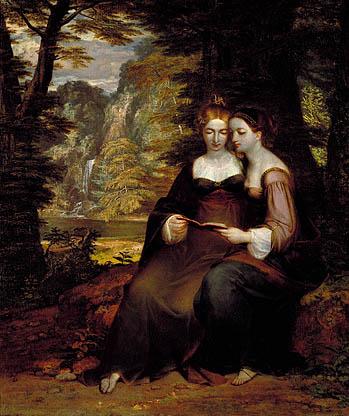Vincent D’Indy’s “Summer’s Day in the Mountains”

Had I to choose a musical summer idyll, my choice would be Jour d’été à la montagne (Summer’s Day in the Mountains), a tone poem by the French Romantic composer Vincent D’Indy. D’Indy (1851–1931) is one of those composers celebrated in their day whose music has since fallen into obscurity (his other “mountain” piece, Symphony on a French Mountain Air, does get an occasional airing). This is unfortunate, for the strength and solidity of his music contrast strikingly with the work of Claude Debussy and Maurice Ravel, his more famous French contemporaries who get much more play today.
D’Indy was born in Paris but had family roots in the south-central Ardèche region, which he would celebrate in his rural tone poem. A child musical prodigy, he attended the Paris Conservatory where he fell under the influence of the Franco-Belgian composer and organist César Franck. Franck’s experiments in harmony and musical structure—including “cyclical” reappearances of musical themes within the course of a composition—and his way of imbuing his music with deeply Catholic beliefs rubbed off notably on D’Indy. In 1894 D’Indy founded his own institution, the Schola Cantorum, to teach musical composition according to Franck’s ideals and methods. He founded the school partly as an alternative to the Paris Conservatory and in the hopes of reforming French music, which he thought corrupted by frivolity and sensualism. According to musicologist Martin Cooper, the Schola also aimed at combating aestheticism, the “divorce of music from the rest of the human personality”—an idea which is relevant to the piece under discussion. D’Indy’s agenda as pedagogue included a new openness to German music, particularly Wagner, but his curriculum embraced the entire musical tradition beginning with Gregorian chant and folk music and ending with the best of the contemporary scene. Through the Schola he taught and influenced a whole generation of composers into the 20th century.
D’Indy’s activities as a teacher have tended to overshadow his own considerable output as a composer, which included four symphonies, numerous symphonic poems, chamber music, sacred choral music, and several operas. His life and music bridged late Romanticism and the early 20th century.
Jour d’été à la montagne, styled a “symphonic triptych,” was written in 1905, by which time D’Indy was firmly established as one of France’s leading composers. Martin Cooper writes that “D’Indy in this work does for the mountains what Debussy in La Mer did for the sea, and in precisely the same year.” The tone poem depicts an entire summer day, from dawn to dusk, such as it might be experienced in the mountains of southwest France. It is scored for a large orchestra, including two harps and a piano. The original score was accompanied by poems for each of the three movements.
In the first movement, Aurore, D’Indy depicts in remarkable fashion the passage from darkness to light. The opening is one of the most awesome and primal in all symphonic music: a pianissimo, sustained, unison C in the strings, to which a fifth is added. We gradually hear the twittering of birds in the woodwinds, and the growth of light and color is evoked with the gradual addition of instruments, ending with a blazing trumpet fanfare in B major as full sunlight arrives. The feeling of airborne optimism here is emblematic of the French school at its best. The movement, a perfectly conceived crescendo of color and intensity, lasts about eight minutes and feels shorter.
In the second movement, Jour: Après-midi sous les pins, D’Indy gives us a languid siesta in the cool shade of gently swaying pine trees—all depicted through musical sonority and texture. This sublimely tranquil music is interrupted by rough peasant dancing—in effect, a scherzo. After a marvelously realistic rumble of thunder in the timpani—a passing storm on the horizon—the music sinks back into the original tranquility. This long, spacious movement could almost stand on its own.
The final movement of the triptych is Soir. The jolly folkish theme that opens the movement suggests laborers returning home at the end of the workday. Then, gradually, D’Indy depicts day fading into evening by quoting, in orchestral garb, a Gregorian chant for Vespers on the Feast of the Assumption (August 15). The entire movement is in rondo form, with a recurring refrain (the jolly opening melody) alternating with contrasting episodes (the chant), and the whole gradually winding down in pace. Toward the end, D’Indy imitates the tolling of the church bells in a starkly modern-sounding passage for winds and piano. The chant is transformed into a deeply moving elegy in the strings. Finally, and magically, D’Indy returns to the shadowy, crepuscular opening music of Aurore, showing how the day has come full circle, sinking into the darkness from which it came. As the final chord is held, we hear in the solo woodwinds what can only a lone wolf howling in the distant mountains. At last, everything subsides into the mystery of night.
Musicologist Andrew Thomson writes that D’Indy wished to suggest in this movement the triumph of Christianity over the forces of darkness and paganism. Let us pause for a moment on this. D’Indy liked to distinguish his compositional method from Debussy’s, and indeed the two might be seen as fundamentally opposed. Debussy’s music is all about atmosphere and sound for its own sake; D’Indy by contrast believed in the importance of strong themes and thematic development in the classical sense. He decried Debussy’s manner as style papier peint (painted paper style), describing it as “a transitory art that lacks a solid foundation.” Although both D’Indy and Debussy might be considered Impressionists, D’Indy’s music goes beyond the mere depiction of nature and reflection of sensations. He builds his tone poem much in the manner of a symphony, starting with well-formed and memorable themes—Debussy typically works from motifs, mere whisps of material—and then developing them, leading us on a musical narrative journey. In this concern for musical structure, D’Indy shows himself very much the heir of Beethoven.
The work also has something of the grandeur of Wagner, but without that composer’s tendency to bombast. Gallic lightness and charm serve to keep everything in balance. A good example is the succinctness with which D’Indy builds his musical sunrise. The scenes D’Indy evokes are homey, straight from everyday life: peasants taking a siesta, church bells calling worshippers to vespers. No gods and mythic heroes here. This lack of pretention is typical of the French musical tradition at its best; yet D’Indy creates the perfect synthesis of French lightness and German gravitas.
His music also has greater warmth than Debussy’s rather cool pantheistic evocations of nature (from which human beings are usually absent), and his scene painting is presided over by a conspicuously Christian and human view of reality. We hear in this tone poem not merely the patterns of the natural world, but their psychological and spiritual meaning. In Aurore D’Indy suggests nothing less than the splendor of the Creation; he later evokes the delights of repose, religious worship, and the final consecration of day to the Creator. Underlying all of this is D’Indy’s aesthetic conviction in the superiority of design and concept over momentary impressions.
Jour d’été à la montagne is one of the most glorious and beautiful of all sonic landscapes, a worthy land-lover’s companion piece to Debussy’s much more famous La mer. In the annals of “pictorial” music, French music, and symphonic music in general, it deserves a far higher place.




